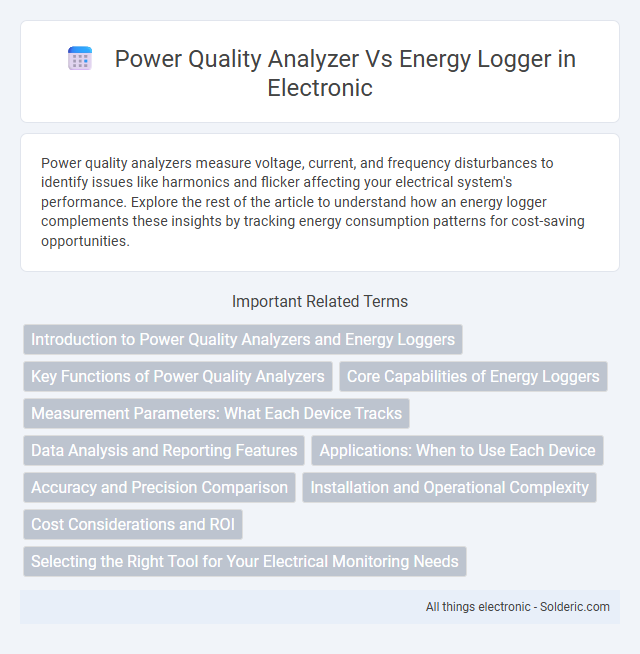Power quality analyzers measure voltage, current, and frequency disturbances to identify issues like harmonics and flicker affecting your electrical system's performance. Explore the rest of the article to understand how an energy logger complements these insights by tracking energy consumption patterns for cost-saving opportunities.
Comparison Table
| Feature | Power Quality Analyzer | Energy Logger |
|---|---|---|
| Primary Function | Measures and analyzes power quality parameters like voltage sags, swells, harmonics, and transients. | Records and monitors energy consumption over time for billing and efficiency analysis. |
| Key Metrics | Voltage, current waveform distortions, harmonics, power factor, frequency deviations. | Total energy usage (kWh), demand, load profile, voltage and current basic measurements. |
| Use Case | Troubleshooting power disturbances and compliance with power quality standards (IEEE 519, IEC 61000-4-30). | Energy management, cost allocation, monitoring consumption trends. |
| Data Granularity | High-resolution waveform capture and event logging. | Periodic interval data logging (minutes to hours). |
| Typical Users | Electrical engineers, maintenance teams, power quality consultants. | Energy managers, facility managers, utility companies. |
| Hardware Complexity | Advanced sensors and processing for detailed waveform analysis. | Simpler sensors focused on energy measurement. |
| Cost | Generally higher due to advanced analytics capability. | Lower cost, focusing on long-term energy tracking. |
Introduction to Power Quality Analyzers and Energy Loggers
Power Quality Analyzers measure voltage, current, frequency, harmonics, and transient disturbances to assess electrical system performance and identify power quality issues. Energy Loggers primarily track energy consumption over time, recording parameters such as kilowatt-hours and load profiles to optimize energy usage and reduce costs. Both devices are essential for comprehensive energy management, but Power Quality Analyzers focus on system integrity while Energy Loggers emphasize consumption monitoring.
Key Functions of Power Quality Analyzers
Power quality analyzers primarily measure and diagnose electrical power parameters such as voltage sags, swells, harmonics, and transients to ensure the stability and reliability of your electrical system. They capture detailed waveform data, analyze power factor, and identify disturbances that can lead to equipment malfunction or energy loss. This in-depth monitoring distinguishes them from energy loggers, which mainly track energy consumption over time without providing comprehensive power quality diagnostics.
Core Capabilities of Energy Loggers
Energy loggers specialize in accurately capturing and storing electrical consumption data over time, providing detailed insights into your energy usage patterns and peak demand periods. They measure parameters such as voltage, current, power factor, and total energy consumption, enabling efficient energy management and cost reduction. These devices are ideal for long-term monitoring and identifying opportunities for improving energy efficiency in residential, commercial, and industrial settings.
Measurement Parameters: What Each Device Tracks
Power quality analyzers measure voltage, current, harmonics, power factor, frequency, and transient disturbances to assess electrical system performance and detect power quality issues. Energy loggers primarily track energy consumption, power demand, voltage, and current over time to monitor usage patterns and optimize energy efficiency. Each device targets specific measurement parameters tailored to different aspects of electrical system monitoring and management.
Data Analysis and Reporting Features
Power quality analyzers offer advanced data analysis and detailed reporting features, capturing voltage, current, harmonics, and transient events to identify power disturbances and improve system reliability. Energy loggers focus primarily on long-term energy consumption trends, providing clear reports on usage patterns and efficiency to help optimize energy costs. Your choice depends on whether you need comprehensive power quality diagnostics or straightforward energy monitoring and reporting.
Applications: When to Use Each Device
Power quality analyzers are essential for diagnosing electrical disturbances, harmonics, and transient events in industrial and commercial power systems where maintaining voltage stability and compliance is critical. Energy loggers are designed for long-term monitoring of energy consumption patterns, cost allocation, and efficiency assessments in residential, commercial, or industrial settings. You should choose a power quality analyzer for troubleshooting power issues and an energy logger for tracking energy usage trends and optimizing consumption.
Accuracy and Precision Comparison
Power quality analyzers provide higher accuracy and precision by measuring detailed electrical parameters such as voltage distortions, harmonics, and transient events, essential for diagnosing complex power issues. Energy loggers primarily focus on total energy consumption with less granular data, offering sufficient precision for billing and energy management but lacking the detailed insights found in power quality analyzers. Your choice depends on whether you need meticulous fault diagnostics or broad energy usage monitoring.
Installation and Operational Complexity
Power quality analyzers typically require more complex installation due to their need for precise sensor placement and calibration to capture detailed electrical disturbances. Energy loggers offer simpler setup procedures, often involving plug-and-play devices that record consumption data over time with minimal user intervention. Your choice depends on whether you prioritize detailed power quality diagnostics or straightforward energy usage monitoring.
Cost Considerations and ROI
Power quality analyzers typically incur higher upfront costs due to advanced diagnostics and detailed waveform analysis capabilities, while energy loggers offer more budget-friendly options focused on long-term energy consumption monitoring. Evaluating ROI requires balancing initial investment against the specific insights needed; power quality analyzers can prevent costly equipment failures by identifying power disturbances, whereas energy loggers help reduce utility expenses through usage tracking. Your decision should align with whether detailed power quality data or ongoing energy consumption metrics deliver the most financial benefit for your application.
Selecting the Right Tool for Your Electrical Monitoring Needs
Power quality analyzers provide detailed insights into voltage, current, harmonics, and transient events critical for diagnosing electrical disturbances, while energy loggers focus on measuring energy consumption and load profiles over time for cost management and efficiency tracking. Selecting the right tool depends on whether Your priority is identifying power quality issues or monitoring energy usage patterns. For comprehensive electrical monitoring, combining both devices ensures accurate diagnostics and informed energy management decisions.
power quality analyzer vs energy logger Infographic

 solderic.com
solderic.com